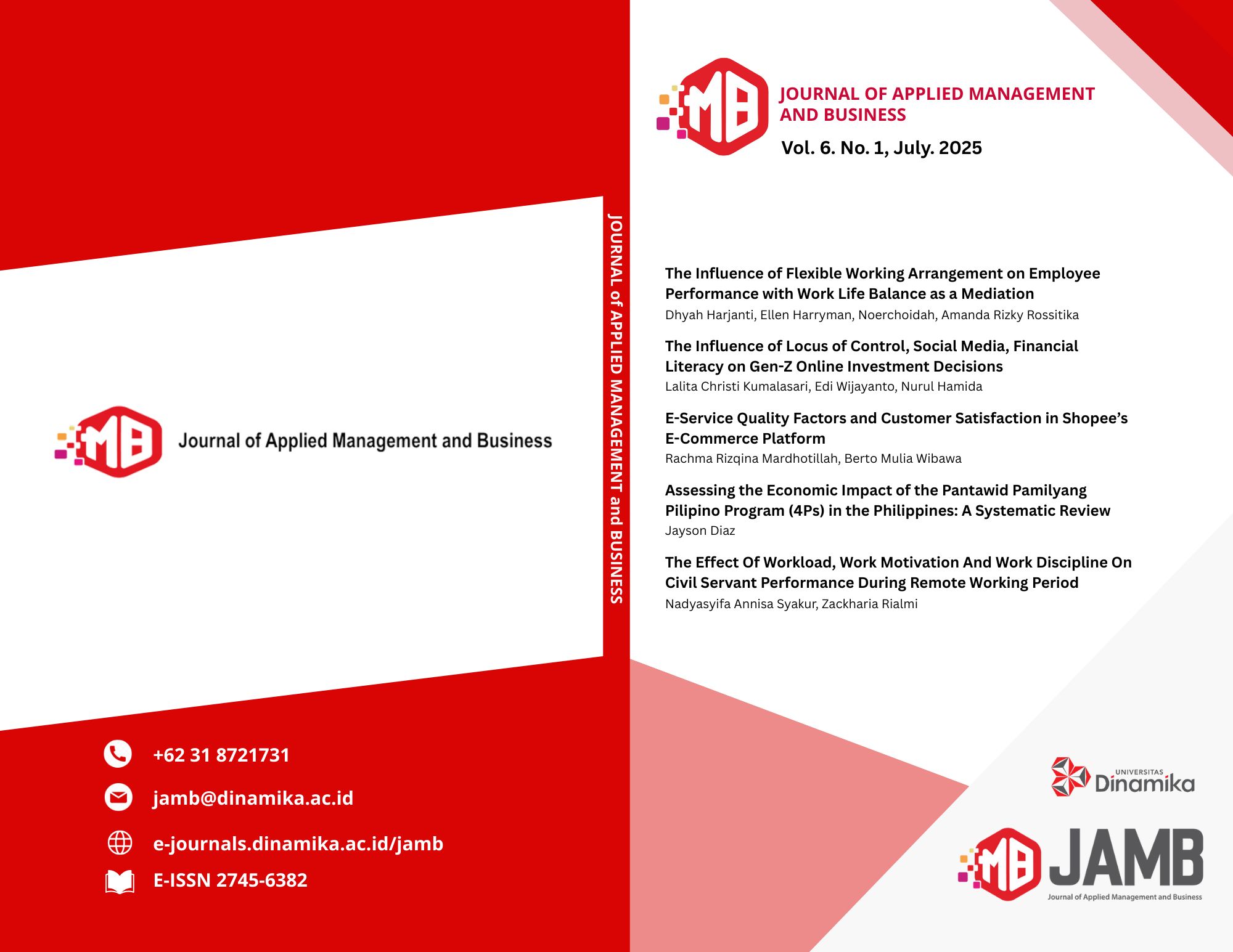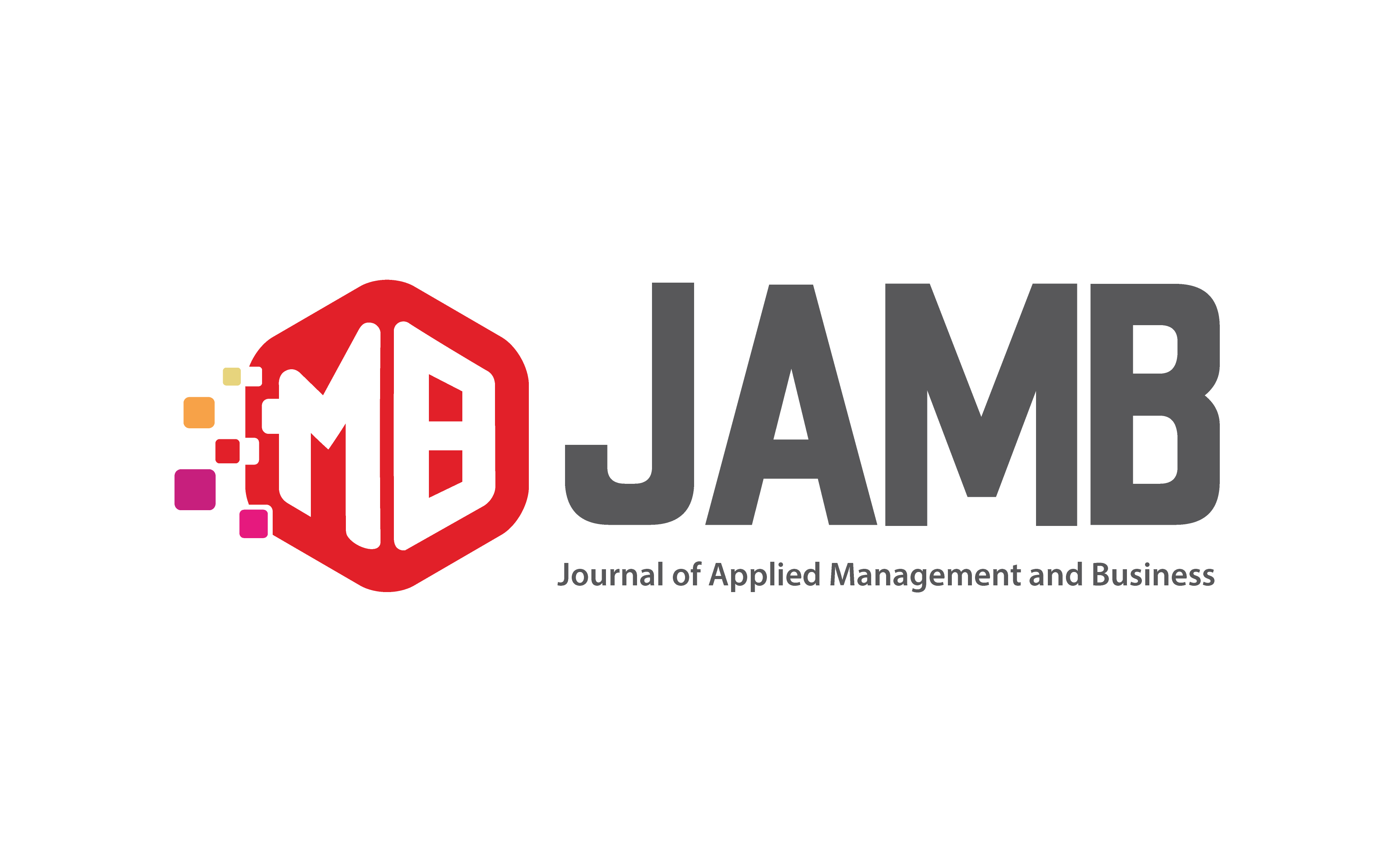E-Service Quality Factors and Customer Satisfaction in Shopee’s E-Commerce Platform
DOI:
https://doi.org/10.37802/jamb.v6i1.1050Keywords:
Customer Satisfaction, E-service Quality, Reliability, Responsiveness, SecurityAbstract
The rapid growth of e-commerce has intensified competition among platforms in providing the best services to customers. Shopee, one of the largest e-commerce platforms in Southeast Asia, faces challenges in maintaining e-service quality that enhances customer satisfaction. This study aims to analyze the influence of security, reliability, and responsiveness on e-service quality, as well as its impact on customer satisfaction in Shopee's e-commerce platform. This research employs a quantitative approach with purposive random sampling, involving 150 Shopee users as respondents. The data collected were analyzed using structural equation modeling-partial least squares (SEM-PLS). The results indicate that security, reliability, and responsiveness have a positive and significant impact on e-service quality. Furthermore, e-service quality positively and significantly influences customer satisfaction. These findings suggest that transaction security, system reliability, and customer service responsiveness are key factors in building high-quality e-commerce services. Therefore, Shopee must continuously improve its security system, maintain platform stability, and enhance customer service responsiveness to increase customer satisfaction and loyalty.
Downloads
References
R. Ashiq and A. Hussain, “Exploring the effects of e-service quality and e-trust on consumers’ e-satisfaction and e-loyalty: insights from online shoppers in Pakistan,” Journal of Electronic Business & Digital Economics, vol. 3, no. 2, pp. 117–141, Jun. 2024, doi: 10.1108/JEBDE-09-2023-0019.
V. A. Z. and L. L. B. A. Parasuraman, “‘Servqual: A Multiple-Item Scale for Measuring Consumer Perceptions of Service Quality,’” Journal of Retailing, vol. 64, no. 1, pp. 12–37, 1988.
X. J. Mamakou, P. Zaharias, and M. Milesi, “Measuring customer satisfaction in electronic commerce: the impact of e-service quality and user experience,” International Journal of Quality & Reliability Management, vol. 41, no. 3, pp. 915–943, Feb. 2024, doi: 10.1108/IJQRM-07-2021-0215.
Katadata, “Account Hacking Cases on Shopee Increase, What Are the Causes?" ,” Katadata, 2022.
J. Valencia, S. Alie, R. Wulandari, and S. Hamali, “Effect of Security, Privacy, and Customer Satisfaction on E-Commerce Consumer Trust,” in 2024 International Conference on Informatics, Multimedia, Cyber and Information System (ICIMCIS), IEEE, Nov. 2024, pp. 429–434. doi: 10.1109/ICIMCIS63449.2024.10957101.
M. V. Djulianto, A. Poerna Wardhanie, and C. Candraningrat, “The Role Of Perceived Usability, Satisfaction, And Customer Trust In Design And Developing User Loyalty Edutech Website,” Business and Finance Journal, vol. 7, no. 2, pp. 183–194, Oct. 2022, doi: 10.33086/bfj.v7i2.3493.
We Are Social, “E-Commerce Consumer Behavior in Indonesia,” We Are Social, 2023.
S. Kim, J. Kim, and S. Park, “The Effects of Perceived Value, Website Trust and Hotel Trust on Online Hotel Booking Intention,” Sustainability, vol. 9, no. 12, p. 2262, Dec. 2017, doi: 10.3390/su9122262.
M. A. Nangin, I. R. G. Barus, and S. Wahyoedi, “The Effects of Perceived Ease of Use, Security, and Promotion on Trust and Its Implications on Fintech Adoption,” Journal of Consumer Sciences, vol. 5, no. 2, pp. 124–138, Aug. 2020, doi: 10.29244/jcs.5.2.124-138.
O. Saoula et al., “Building e-trust and e-retention in online shopping: the role of website design, reliability and perceived ease of use,” Spanish Journal of Marketing - ESIC, vol. 27, no. 2, pp. 178–201, Aug. 2023, doi: 10.1108/SJME-07-2022-0159.
M. Cao, Q. Zhang, and J. Seydel, “B2C e‐commerce web site quality: an empirical examination,” Industrial Management & Data Systems, vol. 105, no. 5, pp. 645–661, Jun. 2005, doi: 10.1108/02635570510600000.
I. Ahmad, R. Akbar, and M. A. Javed, “Nexus between e-service quality and e-customer satisfaction through functional and hedonic values: case of online shopping in Pakistan,” Kybernetes, vol. 54, no. 2, pp. 771–788, Jan. 2025, doi: 10.1108/K-06-2023-1146.
A. Demir, L. Maroof, N. U. Sabbah Khan, and B. J. Ali, “The role of E-service quality in shaping online meeting platforms: a case study from higher education sector,” Journal of Applied Research in Higher Education, vol. 13, no. 5, pp. 1436–1463, Dec. 2021, doi: 10.1108/JARHE-08-2020-0253.
F. Chu and X. Zhang, “Satisfaction, trust and online purchase intention: A study of consumer perceptions,” in 2016 International Conference on Logistics, Informatics and Service Sciences (LISS), IEEE, Jul. 2016, pp. 1–4. doi: 10.1109/LISS.2016.7854436.
A. Abror, D. Patrisia, Y. Engriani, S. Evanita, Y. Yasri, and S. Dastgir, “Service quality, religiosity, customer satisfaction, customer engagement and Islamic bank’s customer loyalty,” Journal of Islamic Marketing, vol. 11, no. 6, pp. 1691–1705, Nov. 2019, doi: 10.1108/JIMA-03-2019-0044.
J. F. Hair, A Primer on Partial Least Squares Structural Equa- tion Modeling (PLS-SEM). Los Angeles: SAGE Publication, 2017.
B. Kaur, J. Kaur, S. K. Pandey, and S. Joshi, “e-Service Quality: Development and Validation of the Scale,” Global Business Review, vol. 24, no. 5, pp. 953–971, Oct. 2023, doi: 10.1177/0972150920920452.
S. Singh, “Measuring E-Service Quality and Customer Satisfaction with Internet Banking in India,” Theoretical Economics Letters, vol. 09, no. 02, pp. 308–326, 2019, doi: 10.4236/tel.2019.92023.
C. Fornell and D. F. Larcker, “Evaluating Structural Equation Models with Unobservable Variables and Measurement Error,” Journal of Marketing Research, vol. 18, no. 1, pp. 39–50, Feb. 1981, doi: 10.1177/002224378101800104.
J. F. Hair, J. J. Risher, M. Sarstedt, and C. M. Ringle, “When to use and how to report the results of PLS-SEM,” European Business Review, vol. 31, no. 1, pp. 2–24, Jan. 2019, doi: 10.1108/EBR-11-2018-0203.
J. F. Hair Jr, M. Sarstedt, L. Hopkins, and V. G. Kuppelwieser, “Partial least squares structural equation modeling (PLS-SEM),” European Business Review, vol. 26, no. 2, pp. 106–121, Mar. 2014, doi: 10.1108/EBR-10-2013-0128.
J. F. Hair Jr, M. Sarstedt, L. Hopkins, and V. G. Kuppelwieser, “Partial least squares structural equation modeling (PLS-SEM),” European Business Review, vol. 26, no. 2, pp. 106–121, Mar. 2014, doi: 10.1108/EBR-10-2013-0128.
M. A. Khan, S. S. Zubair, and M. Malik, “An assessment of e-service quality, e-satisfaction and e-loyalty,” South Asian Journal of Business Studies, vol. 8, no. 3, pp. 283–302, Oct. 2019, doi: 10.1108/SAJBS-01-2019-0016.
Gefen, Karahanna, and Straub, “Trust and TAM in Online Shopping: An Integrated Model,” MIS Quarterly, vol. 27, no. 1, p. 51, 2003, doi: 10.2307/30036519.
M. Fassnacht and I. Koese, “Quality of Electronic Services,” J Serv Res, vol. 9, no. 1, pp. 19–37, Aug. 2006, doi: 10.1177/1094670506289531.
L. Fang, Z. Lu, and L. Dong, “Differentiating service quality impact between the online and off-line context: an empirical investigation of a corporate travel agency,” International Hospitality Review, vol. 35, no. 1, pp. 3–18, Jun. 2021, doi: 10.1108/IHR-01-2020-0003.
Y.-F. Kuo, C.-M. Wu, and W.-J. Deng, “The relationships among service quality, perceived value, customer satisfaction, and post-purchase intention in mobile value-added services,” Comput Human Behav, vol. 25, no. 4, pp. 887–896, Jul. 2009, doi: 10.1016/j.chb.2009.03.003.
B. M. Wibawa, R. Octovianisa, R. A. Miyagi, and R. R. Mardhotilah, “Pengaruh Perilaku Komplain dan Kepuasan Penanganan Komplain Terhadap Minat Pembelian Konsumen di E-Commerce,” Jurnal Teknologi Informasi dan Terapan, vol. 6, no. 2, pp. 41–49, Dec. 2019, doi: 10.25047/jtit.v6i2.107.
N. J. Slack and G. Singh, “The effect of service quality on customer satisfaction and loyalty and the mediating role of customer satisfaction,” The TQM Journal, vol. 32, no. 3, pp. 543–558, Feb. 2020, doi: 10.1108/TQM-07-2019-0187.
S. Zygiaris, Z. Hameed, M. Ayidh Alsubaie, and S. Ur Rehman, “Service Quality and Customer Satisfaction in the Post Pandemic World: A Study of Saudi Auto Care Industry,” Front Psychol, vol. 13, Mar. 2022, doi: 10.3389/fpsyg.2022.842141.
Downloads
How to Cite
Issue
Section
License
Copyright (c) 2025 Journal of Applied Management and Business

This work is licensed under a Creative Commons Attribution 4.0 International License.











